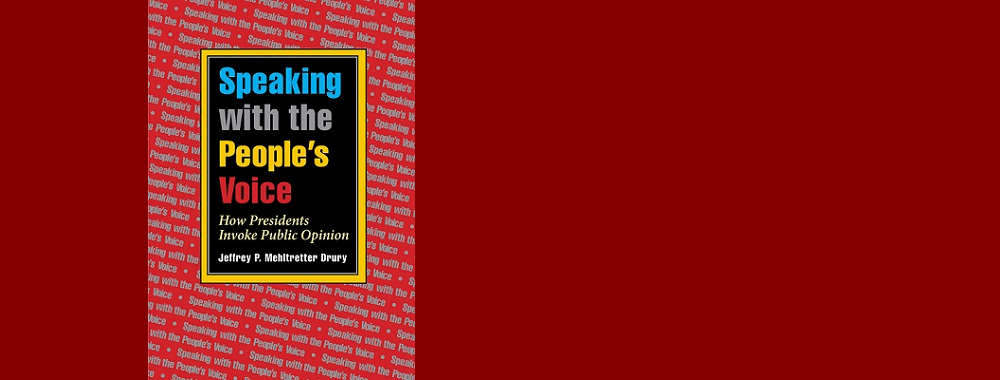Jeffrey P. Mehltretter Drury

Speaking with the People's Voice
FROM THE JACKET |
FROM THE SPRING 2014 PEP REPORT, AMERICAN POLITICAL SCIENCE ASSOC.: |
|---|---|
The role of public opinion in American democracy has been a central concern of scholars who frequently examine how public opinion influences policy makers and how politicians, especially presidents, try to shape public opinion. But in Speaking with the People’s Voice: How Presidents Invoke Public Opinion, Jeffrey P. Mehltretter Drury asks a different question that adds an important new dimension to the study of public opinion: How do presidents rhetorically use public opinion in their speeches? In a careful analysis supported by case studies and discrete examples, Drury develops the concept of “invoked public opinion” to study the modern president’s use of public opinion as a rhetorical resource. He defines the term as “the rhetorical representation of the beliefs and values of US citizens.” Speaking with the People’s Voice considers both the strategic and democratic value of invoked public opinion by analyzing how modern presidents argumentatively deploy references to the beliefs and values of US citizens as persuasive appeals as well as acts of political representation in their nationally televised speeches. Opening with a survey of the conceptual understandings of public opinion and representation in the United States, Drury reveals a tension concerning their purpose from the founding of the nation to present times. The next three chapters report the various rhetorical patterns of invoked public opinion in the major speeches of modern presidents. Each chapter, dedicated to one significant argumentative form—bandwagon appeals, identity appeals, and contra populum appeals—first crystallizes the major functions of the pattern. By presenting characteristic examples from the major speeches of modern presidents, it attends to how these appeals invoke public opinion to invite particular responses from the audience and to engage in symbolic representation. Each chapter then reports a case study of a significant presidential speech to illustrate how the functions of that particular appeal might jointly operate in context to produce meaning and invite political action. Finally, the book concludes by considering the competing impulses of control and empowerment in invoked public opinion and their implications for presidential leadership and US democracy in a modern age. |
The seed for Speaking with the People’s Voice was planted in 2003 by my graduate work at the University of Wisconsin. As a rhetorically trained scholar studying presidents and public opinion, I wondered: If polls are so important to presidential politics, why don’t modern presidents talk about them very often in their national rhetoric? Since then, the project evolved to question how presidents use invoked public opinion—or speak with the people’s voice—in their major speeches and what this invoked public opinion means for presidential leadership. As citizens, we have become accustomed to hearing presidents talk about the beliefs and desires of average citizens and recognize them as heroic models for others to emulate. It seems unlikely that presidents would invest so much time and energy into invoked public opinion if there was no rhetorical value. So rather than dismiss invoked public opinions as populist platitudes, this book considers the argumentative forms and functions of these appeals. Speaking with the People’s Voice reports the results of my analysis of more than 220 presidential speeches (from JFK to GWB). I found that presidents tend to use invoked public opinion through three different, recurring argumentative patterns tailored to various situations, goals, and audiences. Two of these patterns support public opinion but do so for different audiences; bandwagon appeals use one public’s opinion to persuade a different public of a conclusion while identity appeals use a public’s opinion to persuade that same public of a conclusion. The third pattern argues against public opinion by offering alternative criteria for reaching the president’s conclusion. In delineating each kind of appeal, I offer broad illustrations from across more than forty years of presidential discourse as well as a single speech case study to illustrate the contextual force of that given appeal. Beyond outlining the typology of appeals, I argue that invoked public opinion helps modern presidents balance two different, and often competing, rhetorical demands of leadership: political representation of the people and presidential power over policy making. While political scholars have often recognized this tension—loosely defined as a distinction between being a delegate or being a trustee, between leading or following public opinion—I illustrate how invoked public opinion is one of the few rhetorical strategies that enable modern presidents to do both, to advocate for their own political initiatives while simultaneously representing the beliefs and values of the American people. I hope that this book will provide novel insight about the relationship between presidents and public opinion as I explore a less concrete and discrete form of public opinion than poll results. In the end, Speaking with the People’s Voice asks those in fields such as politics, rhetoric, history, and American studies to seriously consider how modern presidential rhetoric—particularly invoked public opinion—serves as political representation alongside the more traditional focus on persuasion. |
REVIEWS |
|
Azari, Julia R. Perspectives on Politics 13.3 (2015): 863-864. Crouch, J. P. Choice 52.3 (2014): 52-1684. Eshbaugh-Soha, Matthew. Congress & the Presidency 42.2 (2015): 237-239. Hudkins, Jay M. Presidential Studies Quarterly 45.2 (2015): 408-410. Kurr, Jeffrey A. Rhetoric & Public Affairs 19.1 (2016): 135-138. Vaughn, Justin S. Political Science Quarterly 130.1 (2015): 171-173.
|